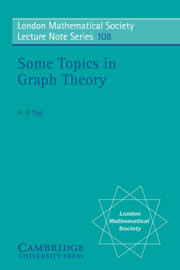Chapter 2 - Edge–colourings of Graphs
Published online by Cambridge University Press: 19 March 2010
Summary
Introduction and definitions
The notion of an edge-colouring of a graph can be traced back to 1880 when Tait tried to prove the Four Colour Conjecture. (A detailed account of this can be found in many existing text books on Graph Theory and therefore we shall not repeat it here.) However, there was not much development during the period 1881–1963, A breakthrough came in 1964 when Vizing proved that every graph G having maximum valency Δ can be properly edge-coloured with at most Δ + 1 colours (“proper” means that no two adjacent edges of G receive the same colour). This result generalizes an earlier statement of Johnson [63] that the edges of every cubic graph can be properly coloured with four colours.
Many of the results of this chapter will be concerned with the socalled ‘critical graphs’ introduced by Vizing in the study of classifying which graphs G are such that x'(G) = Δ(G) + 1. The main reference of this chapter is Fiorini and Wilson [77].
We now give a few definitions. Let G be a graph or multigraph. A (proper, edge-) colouring π of G is a map π : E(G) → {1,2,…} such that no two adjacent edges of G have the same image. The chromatic index χ'(G) of G is the minimum cardinality of all possible images of colourings of G. Hence, if Δ = Δ(G), then it is clear that χ'(G) > Δ and Vizing's theorem says that Δ < χ'(G) < Δ + 1. If χ'(G) = Δ, G is said to be of class 1, otherwise G is said to be of class 2.
- Type
- Chapter
- Information
- Some Topics in Graph Theory , pp. 9 - 87Publisher: Cambridge University PressPrint publication year: 1986



